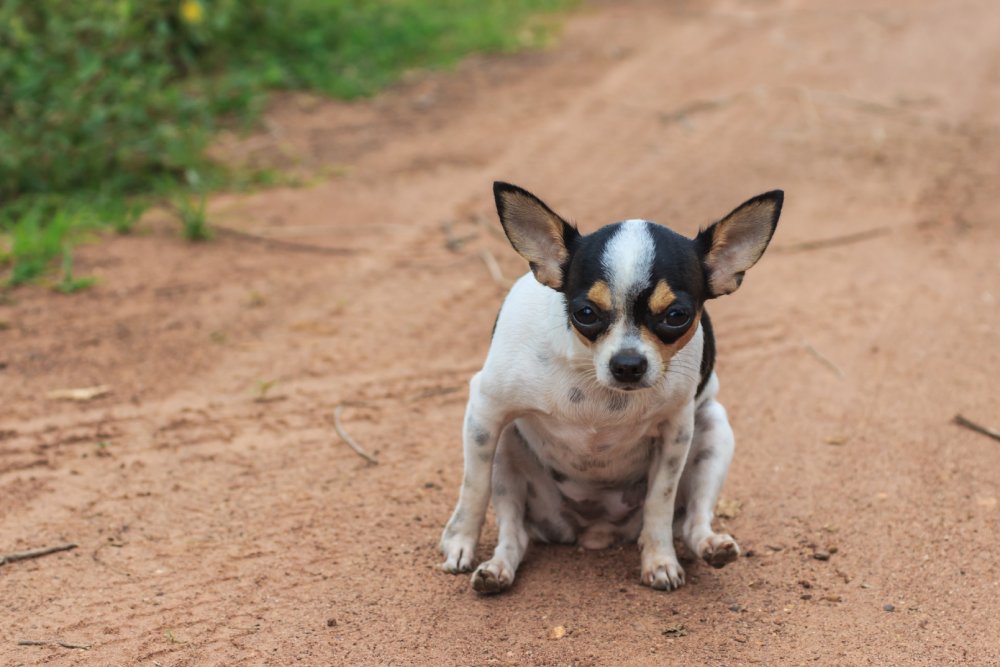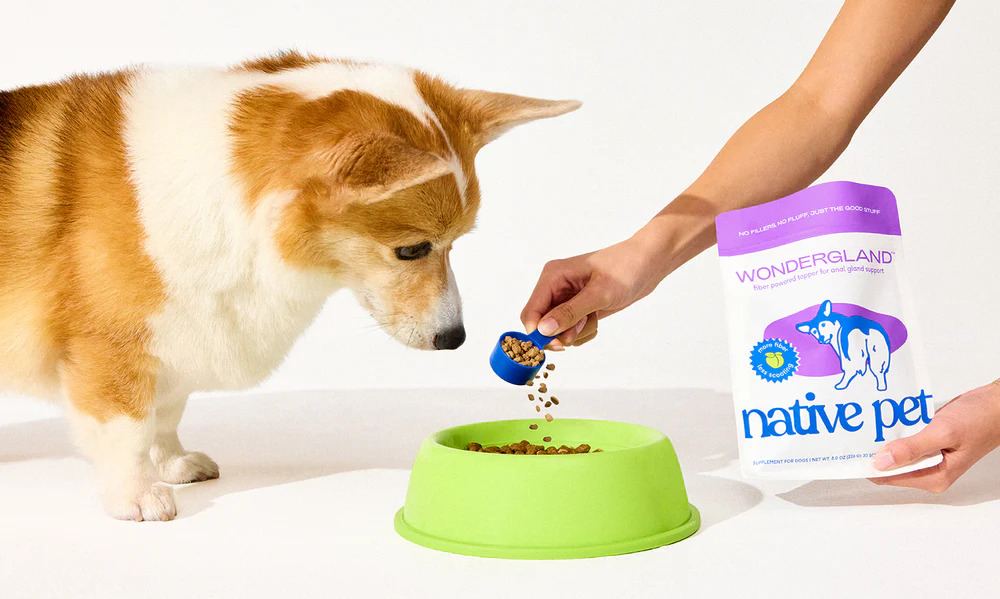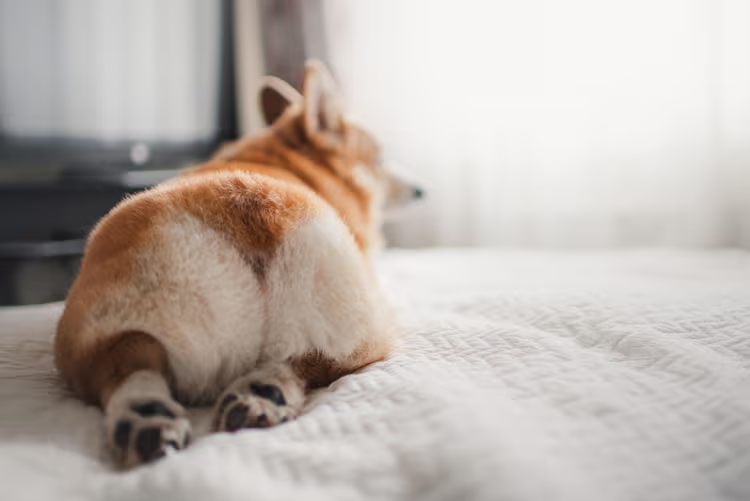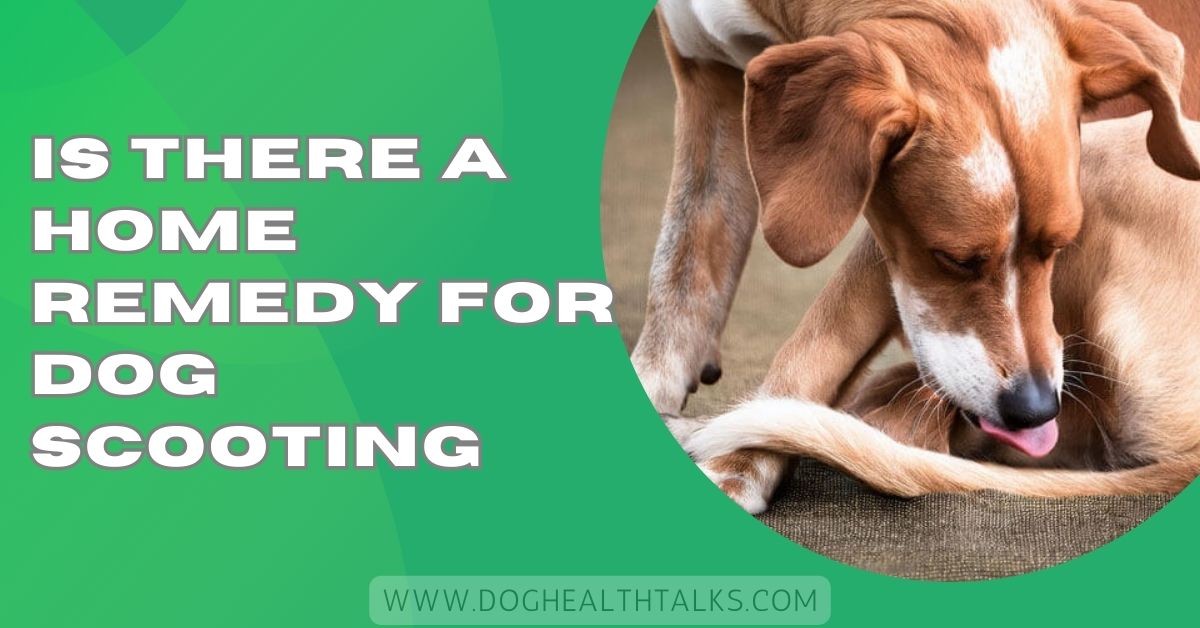If your dog is sliding its bottom across the floor, you’re probably worried — and maybe a little embarrassed. This behavior, known as scooting, is often a sign of irritation or discomfort in the area around your dog’s rear end.
Yes, there are simple home remedies for dog scooting. Keep your dog clean, trim hair, use warm compresses, add fiber-rich foods, and maintain a balanced diet. Express anal glands if needed for relief.
This guide explains why dogs scoot, the top home remedies that actually work, and when it’s time to call your vet.
Dogs often scoot when they feel irritation, itching, or discomfort around their rear end. The most common reason is anal gland problems—when these small sacs don’t empty naturally, they become full or infected, making your dog drag their rear to get relief.
Scooting can also be caused by allergies, parasites, skin infections, or even a poor diet, leading to loose stools.
While an occasional scoot may not be serious, frequent scooting means something needs attention.
The safest approach is to check for obvious issues, keep the area clean, and consult your veterinarian if the problem persists.

Keeping your dog’s rear end trimmed and clean prevents irritation that can lead to scooting. Long hair can trap dirt, feces, or moisture, causing itching and discomfort.
Regular sanitary clipping, combined with gentle cleaning, ensures the area remains hygienic, making your dog feel comfortable and reducing the risk of skin infections or scooting.
A warm compress can ease swelling or discomfort caused by full anal glands. Soak a clean cloth in warm water, wring it out, and gently press it against your dog’s bottom for a few minutes. This soothing method encourages natural drainage and gives safe, gentle relief from irritation.
Omega-3 fatty acids reduce inflammation, ease itching, and promote healthier skin. Adding safe supplements like fish oil to your dog’s diet supports anal gland health and reduces irritation that causes scooting.
Always consult your veterinarian for the correct dosage to keep your dog comfortable and safe in the long term.
Bathing your dog with mild, pet-safe shampoo soothes irritated skin and removes allergens or bacteria.
A soothing bath can help reduce itching around the bottom and keep your dog clean. Regular baths, especially after outdoor play, prevent scooting by removing dirt and simply promoting healthy skin hygiene.
Adding fiber to your dog’s meals improves digestion and helps naturally empty anal glands during bowel movements.
Foods like pumpkin, carrots, or vet-approved fiber supplements keep stools firm, making gland expression easier.
This simple dietary change supports gut health, reduces irritation, and minimizes the need for frequent scooting.
Sometimes, dogs need help releasing their full anal glands, which is a significant cause of scooting.
You can learn to do this at home safely, but many owners prefer to have a groomer or veterinarian handle it. Proper expression relieves pressure, prevents infection, and keeps your dog comfortable and itch-free.
A warm compress helps ease swelling and discomfort in the anal area. Soak a clean cloth in warm water, wring it out, and gently press against the spot. This quick and safe remedy provides soothing relief for many dogs.
If your dog’s anal glands don’t empty naturally, they may need gentle expression. Veterinarians or groomers can perform this safely, but you can also learn to do it yourself.
Always consult your veterinarian for guidance, as using the wrong technique can harm your dog.

Keeping your dog clean and brushed prevents debris, mats, or feces from sticking to the bottom.
Regular grooming also helps reduce skin irritation and infections that can trigger scooting. A tidy coat makes your dog feel comfortable, fresh, and itch-free.
Adding more fiber or balanced nutrients helps regulate digestion and firm up stools. This natural pressure helps anal glands empty during bowel movements.
Simple changes, such as switching to pumpkin or a healthy dog food, can help resolve scooting issues linked to diet.
Probiotics and prebiotics enhance gut health, bolster immunity, and regulate digestion. A healthy gut supports regular bowel movements, reducing pressure on anal glands.
You can use vet-approved supplements or natural foods, such as yogurt, for safe, long-term relief.
Hydration plays a key role in smooth digestion. Encourage your dog to drink more water by offering fresh bowls, wet food, or pet fountains.
Proper hydration helps maintain healthy stools, supports gland function, and reduces the risk of constipation.
Here are 10 safe remedies to try, with details on how to use them. Always test for sensitivity, introduce things gradually, and stop if any remedy worsens the issue.
| Remedy | How It Helps | How to Apply / Use | Cautions |
| 1. Increase Fiber in Diet | Firmer stools help naturally express anal glands; better gut health reduces irritation. | Add plain canned pumpkin (no sugar or spices), cooked sweet potato, green beans, or fiber supplements. Introduce gradually to avoid gas or upset. | Too much fiber too fast can cause bloating, gas, diarrhea. Always mix with existing diet and monitor stool. |
| 2. Warm Compresses | Soothes swelling, helps soften impactions, improves comfort. | Use a clean cloth soaked in warm (not hot) water. Apply to the anal area for 5-10 minutes, 2-3 times per day. | Make sure water isn’t too hot; avoid open wounds. Use gentle pressure. |
| 3. Anal Gland Expression (Manual or by Groomer) | If glands are full and not emptying properly, manual expression helps relieve pressure. | If you are experienced / confident, you can carefully express the glands. Otherwise, have a groomer or vet do it. Be gentle and clean. | Risky if done improperly: can cause injury or infection. If swelling or infection present, best leave to a professional. |
| 4. Probiotics & Gut Support | Helps with digestion, reduces loose stool, can reduce irritation of the anal area. | Give canine-safe probiotics or use probiotic-rich foods. Consult your vet for dosage or selection. | Use vet-recommended products. Some dogs may have adverse reactions; monitor stool for changes. |
| 5. Good Hygiene & Grooming | Removing fecal residue, trimming hair can reduce irritation. | After bowel movements, gently clean the area with warm water, unscented wipes. Trim fur around the anus to prevent mats and accumulation. | Be gentle; avoid harsh soaps or products with strong fragrance. Dry thoroughly. |
| 6. Oatmeal or Soothing Baths | Calms itchy or inflamed skin, can reduce irritation. | Use an oatmeal shampoo or finely ground oats mixed in warm bath water. Soak or rinse the affected area. Pat dry. | Avoid letting your dog ingest shampoo; ensure bath water is clean; do not use if wounds are open without vet guidance. |
| 7. Natural Anti-Inflammatory / Soothing Topicals | Witch hazel, aloe vera, calendula, coconut oil reduce inflammation and relieve itching. | Dilute witch hazel, use pure aloe vera gel or calendula infusion. Apply gently to the irritated skin. Coconut oil can be used topically or in small amounts in food. | Avoid if skin is broken or bleeding. Test a small patch first. Some dogs may lick the area; consider barrier or distraction to prevent licking. |
| 8. Apple Cider Vinegar (ACV) | ACV has mild antibacterial and antifungal properties; helps balance skin pH. | Mix equal parts water and raw, unfiltered ACV. Dab onto the affected area (avoid open wounds). Alternatively, a tiny amount can go in water or food if advised by vet. | The solution must be diluted. Do not apply to broken skin — it will sting. Some dogs dislike the smell. |
| 9. Omega-3 Fatty Acids / Fish Oil | Natural anti-inflammatory, helps skin health, reduces irritation. | Use vet-approved fish oil or omega-3 supplements. Follow dosage instructions. Adding fish-rich foods can help. | Risks include possible upset stomach; ensure purity (low heavy metals). Always consult vet before starting, especially if dog is on other medications. |
| 10. Regular Exercise & Adequate Hydration | Helps promote good digestion and healthy stool formation; keeps weight in check so anal glands are less stressed. | Ensure fresh water always available. Walks, play, and activity appropriate for age & breed. Avoid overfeeding; aim for optimal body condition. | If your dog has underlying health problems (heart, joints, etc.), exercise should be within safe limits. Hydration should be balanced; extreme changes may upset stomach. |
Full or irritated anal glands are the top reason dogs scoot. When these glands don’t empty properly, they swell and cause itching.
Scooting helps your dog relieve pressure, but expressing the glands or seeing a vet quickly fixes the root problem.
Allergies from food, pollen, or chemicals can irritate a dog’s bottom, leading to scooting. The skin becomes itchy and inflamed, prompting dogs to scratch and rub themselves in an attempt to find relief.
Identifying the trigger and switching foods, shampoos, or environments helps prevent this uncomfortable issue.
Worms and intestinal parasites often irritate the area around the anus. Dogs may scoot to ease the itching caused by these pests.
Regular deworming, vet check-ups, and maintaining clean living spaces are essential to prevent parasites and stop this unpleasant problem.
Moisture, bacteria, or yeast can trigger skin infections in the area around your dog’s rear. These infections cause redness, swelling, and intense itchiness, which makes scooting common.
Proper cleaning, vet care, and sometimes medication are needed to clear infections and keep your dog comfortable.
Poor diet or lack of fiber can upset digestion and prevent anal glands from emptying naturally.
Loose stools don’t create enough pressure, causing irritation and scooting. Adding fiber, hydration, and balanced meals helps improve digestion and reduce constipation caused by dietary issues.

Pumpkin is a safe, natural fiber source that helps regulate digestion. Firm stools from pumpkin apply pressure on anal glands, allowing them to empty naturally.
A spoonful of plain, cooked pumpkin added to meals can help alleviate constipation and support long-term gut health.
Adding fiber to your dog’s diet helps keep their stools firm and healthy. Fiber-rich foods like oats, carrots, and green beans help naturally express anal glands during bowel movements.
This simple dietary boost reduces scooting while supporting overall digestion and intestinal health.
Lean proteins, such as chicken, turkey, or fish, are easy to digest and less likely to trigger allergies or gastrointestinal issues.
They provide essential nutrients without excess fat, which supports a healthy digestive system, promotes balanced stools, and reduces the likelihood of anal gland irritation.
If your dog continues to scoot even after deworming, the cause is likely not worms. Scooting often results from full anal glands, skin irritation, or allergies that deworming cannot resolve.
At this point, it’s essential to consider other potential triggers, such as diet, grooming needs, or infections.
Simple home remedies may help, but if the problem continues, a vet exam is best. Identifying the real cause ensures your dog gets safe, effective relief instead of temporary fixes.
Scooting typically indicates irritation from anal gland issues, parasites, or allergies. You can help by keeping your dog clean, adjusting its diet to include more fiber, and ensuring regular grooming.
If the problem persists, consult your veterinarian for a thorough examination. Early care helps prevent discomfort and promotes your dog’s overall health.
If your dog scoots right after pooping, it may mean the anal glands aren’t emptying fully. A little irritation from hard stools or a minor infection can also cause it.
Cleaning the area and adding fiber often helps. Your veterinarian should check for persistent scooting to ensure safe relief.
Apples can be a gentle way to add fiber, which helps stool pass smoothly and eases anal gland pressure. A few small slices, without seeds, are safe for most dogs.
Always introduce slowly and watch for digestive upset. For ongoing irritation, seek vet advice for proper treatment.
Female dogs also exhibit scooting behavior for the same reasons as males—anal gland issues, irritation, or parasites.
However, urinary or vaginal infections may also cause scooting in females. If cleaning and home care don’t provide relief quickly, your vet can check for underlying issues and provide the proper treatment to ensure your pet’s comfort.

Diluted apple cider vinegar can sometimes help soothe mild irritation when used externally, but never apply it directly to broken skin or sensitive areas.
Adding a small amount to water may also support digestion. Always consult your veterinarian first to ensure it’s safe for your dog.
Pumpkin is one of the best natural remedies for scooting because it’s rich in fiber. Adding a spoonful of plain canned or cooked pumpkin to meals helps regulate stool, supports anal gland function, and reduces irritation. Start with small amounts and adjust based on your dog’s size.
When female dogs drag their bottoms, it often means irritation from full anal glands, parasites, or infection.
Hormonal changes or urinary issues can also play a role. While mild cases may improve with grooming and diet changes, ongoing scooting should always be evaluated by a veterinarian.
If your dog continues to scoot after being wormed, the cause is likely not parasites. Common triggers include clogged anal glands, allergies, or skin irritation.
Cleaning, fiber-rich foods, or home remedies may help, but persistent scooting requires a vet check to identify and safely address the underlying issue.
You should visit your veterinarian if scooting is frequent, persistent, or accompanied by other symptoms, such as licking, swelling, a bad odor, or blood.
These can signal infections, anal gland abscesses, or other health issues that need medical treatment.
Vets can safely express glands, run tests, and prescribe medications if needed. Don’t wait too long—quick action keeps your dog comfortable and prevents problems from getting worse. When in doubt, it’s always safer to seek professional help for peace of mind.
Scooting typically indicates irritation from anal gland issues, parasites, or allergies. Occasional scooting isn’t serious, but frequent dragging requires cleaning, dietary adjustments, or a veterinary check.
You can help by cleaning the area, adding fiber-rich foods like pumpkin, keeping your hair trimmed, and using soothing baths. If scooting continues, consult your vet.
Fiber-rich foods, such as pumpkin, apples, or dog-safe vegetables, support healthy digestion and anal gland function. A balanced diet makes stools firmer, easing scooting issues naturally.
Sometimes, mild scooting clears up after your dog poops or cleans up, but ongoing scooting often signals anal gland or health issues that require veterinary attention.
Signs include scooting, licking the rear, swelling, or a strong fishy odor. If glands seem full, your vet can safely express them.
Scooting is your dog’s way of telling you something is wrong or uncomfortable. While home remedies like cleaning, adding fiber, regular grooming, and soothing baths often bring relief, it’s essential to monitor how frequently the behavior occurs. Occasional scooting may not be a serious issue, but if it becomes frequent or is accompanied by other symptoms, such as swelling, odor, or bleeding, a vet visit is the safest choice. By combining simple home care with timely veterinary help, you can keep your dog comfortable, healthy, and scoot-free.
